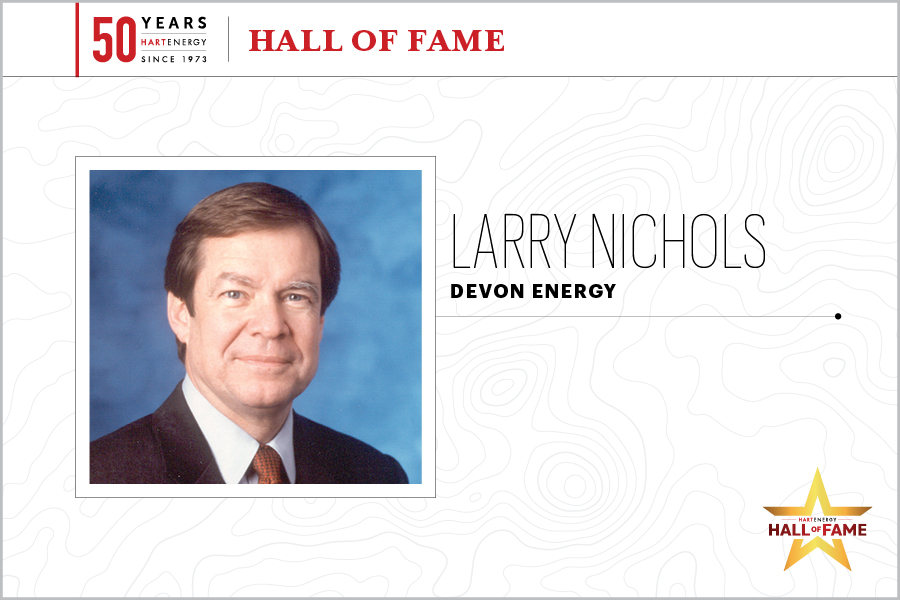Larry Nichols
Editor's note: This profile is part of Hart Energy's 50th anniversary Hall of Fame series honoring industry pioneers of the past 50 years and the Agents of Change (ACEs) who are leading the energy sector into the future.

Larry Nichols recognized the potential of Mitchell Energy & Development’s Barnett development in the Fort Worth Basin in 2001. So, he bought it.
A geologist with a law degree, Nichols was a law clerk to U.S. Supreme Court Chief Justice Earl Warren and an assistant in the Department of Justice to future Supreme Court Chief Justice William Rehnquist before joining his father’s oil and gas business at home in Oklahoma City in 1971.
In 1950, John Nichols had created the first publicly registered oil and gas drilling fund that eventually became Devon Energy. In 1989, the micro-cap independent E&P was in the biggest gas play in the country: the Fruitland coalbed of the San Juan Basin.
And it had worked the play itself; Devon didn’t sell it to a major, which thought undercapitalized U.S. independents would have to divest to them any significant discoveries, while they were leaving the onshore U.S. for prizes abroad.
By 2001, the company forged itself into an E&P with market cap of $16 billion.
Nichols, by then chairman and CEO, bid $3.5 billion for Mitchell Energy.
When George Mitchell put Mitchell Energy up for sale in 1999, Devon had taken a look but passed; the potential of Mitchell’s burgeoning Barnett shale-gas play seemed nascent yet and possibly lacking running room.
In 2001, Mitchell offered the company to Devon again and Nichols took the call. Mitchell’s proved reserves had more than doubled to 2.5 Tcfe in that short time.
After closing in early 2002, Devon quickly proceeded to take the play horizontal and to expand its areal potential beyond where a limestone frac barrier sits above a water-bearing zone.
By January 2005, Devon had 144 Barnett horizontals online. The Barnett field, Newark East, was now the largest gas field in Texas, producing some 1.1 Bcf/d; cumulative production was 1 Tcf. Explorers were trying horizontals in 15 counties with 90 rigs at work.
Nichols said in “The American Shales,” “What we did in 2002 to combine horizontals with hydraulic fracturing in the Barnett was a huge step.… Technology evolves ... It’s not a light switch that is off and then on.
“It’s a light that gets a little bit brighter and brighter.”
Devon went on to develop more tight-rock plays, including in Oklahoma, South Texas, the Permian Basin and the Powder River Basin. Nichols is now chairman emeritus. Devon’s market cap is $30 billion today.
The shale breakthrough is an example of how technology changes in time—and changes the game—he said. “It’s a point you can make about this industry that has happened repeatedly over time—and will in the future.”
Harold Korell, who was trying to turn around Southwestern Energy with $50 million cap in 2001 (and did, into a $7-billion E&P today), said in “The American Shales,” “That was a seismic kind of event in the industry—when Devon bought Mitchell.”
And that it was Devon buying Mitchell that was particularly noteworthy, he added. Nichols and the Devon team had figured out how to get the Fruitland coal to pay in the San Juan Basin in the 1980s.
Now Nichols thought Mitchell was onto something in the Barnett—something worth $3.5 billion.
Korell took note. “That couldn’t help but get your attention.”
—Nissa Darbonne, Executive Editor-at-Large
